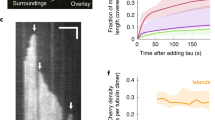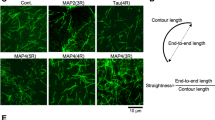Abstract
COS-1 cells were transfected with cDNAs coding for different human tau isoforms. Expressed tau isoforms bind to cellular microtubulesin vivo, preferentially at the distal regions of microtubules nucleated by the centrosome, leading to their stabilization. Eventually, tau-coated microtubules without any association with the centrosome were observed. A major difference between tau isoforms containing three tubulin-binding motifs and tau isoforms containing four tubulin-binding motifs is the greater ability of the latter in inducing the formation of long cytoplasmic processes.
Similar content being viewed by others
References
Baas PW, Hoshi HC: Gamma-tubulin distribution in the neuron: Implications for the origins of neuritic microtubules. J Cell Biol 119: 171–178, 1992
Baudier J, Cole D: Phosphorylation of tau proteins to a state like that in alzheimer's brain is catalyzed by a calcium/calmodulin-dependent kinase and modulated by phospholipid. J Biol Chem 262: 17577–17583, 1987
Binder LI, Frankfurter A, Rebhum L: The distribution of tau in the mammalian central nervous system. J Cell Biol 101: 1371–1378, 1985
Bornens M: Structure and function of isolated centrosomes. In: VI Kalnins (ed.) ‘The Centrosome’, pp 1–43, 1992
Butner K, Kirschner MW: Tau-protein binds to microtubules through a flexible array of distributed weak sites. J Cell Biol 115: 717–730, 1991
Caceres A, Kosik K: Inhibition of neurite polarity by tau antisense oligonucleotides in primary cerebellar neurons. Nature 343: 461–463, 1990
Cleveland D, Hwo SY, Kirschner MW: Purification of tau, a microtubule associated protein that induces assembly of microtubules from purified tubulin. J Mol Biol 116: 207–225, 1977
Cleveland DW, Lopata MA, Sherline P, Kirschner MW: Unpolymerized tubulin modulates the level of tubulin mRNAs. Cell 25: 537–542, 1981
Correas I, Díaz-Nido J, Avila J: Microtubule associated protein tau is phosphorylated by protein kinase C on its tubulin binding domain. J Biol Chem 267: 15721–15728, 1992
Correas I, Padilla R, Avila J: The tubulin binding sequence of brain microtubule associated proteins tau and MAP2 is also involved in actin binding. Biochem J 269: 61–64, 1990
Dinsmore, JH, solomon F: Inhibition of MAP2 expression affects both morphological and cell division phenotypes of neuronal differentiation. Cell 64: 817–826, 1991
Drewes G, Lichtenberg-Kraag B, Doring F, Mandelkow EM, Biernat J, Goris J, Doree M, Mandelkow E: Mitogen activated protein (MAP) kinase transforms tau-protein into an Alzheimer-like state. EMBO J 11: 2131–2138, 1992
Drubin DG, Kirschner MW: Tau protein function in living cells. J Cell Biol 103: 2739–2746, 1986
Edson EK, Weisshaar B, Matus A: Induction of processes on MAP2 transfected non neural cells by cytochalasin. Mol Biol Cell 3: 258a, 1992
Gallo JM, Hanger DP, Twist EC, Kosik KS, Anderton BH: Expression and phosphorylation of a 3-repeat isoform of tau in transfected nonneuronal cells. Biochem J 286: 399–404, 1992
Garcia de Ancos J, Correas I, Avila J: Differences in microtubule binding and self-association abilities of bovine brain tau isoforms. J Biol Chem 268: 7976–7982, 1993
Georgieff I, Liem RK, Mellado W, Nunez J, Shelanski M: High molecular weight tau — preferential localization in the peripheral nervous system. J Cell Sci 100: 55–60, 1991
Gluzman Y: SV40-transformed simian cells support the replication of early SV40 mutants. Cell 23: 175–182, 1981
Goedert M, Jakes R: Expression of separate isoforms of human tau protein: correlation with the tau pattern in brain and effects of tubulin polymerization. EMBO J 9: 4225–4230, 1990
Goedert M, Spillantini MG, Jakes R, Rutherford D, Crowther RA: Multiple isoforms of human microtubule-associated protein tau: sequences and localization in neurofibrillary tangles of Alzheimer's disease. Neuron 3: 519–526, 1989
Goedert M, Wischik CM, Crowther RA, Walker JE, Klug A: Cloning and sequencing of the cDNA encoding a core protein of the paired helical filament of Alzheimer disease: identification as the microtubule-associated protein tau. Proc Natl Acad Sci USA 85: 4051–4055, 1988
Grundke-Iqbal I, Iqbal K, Tung YC, Quinlan M, Wisniewski HM, Binder LI: Abnormal phosphorylation of the microtubule-associated protein tau (tau) in Alzheimer cytoskeletal pathology. Proc Natl Acad Sci USA 83: 4913–4917, 1986
Grunstein M, Hogness DS: Colony hybridization: a method for the
Author information
Authors and Affiliations
Rights and permissions
About this article
Cite this article
Montejo de Garcini, E., de la Luna, S., Dominguez, J.E. et al. Overexpression of tau protein in COS-1 cells results in the stabilization of centrosome-independent microtubules and extension of cytoplasmic processes. Mol Cell Biochem 130, 187–196 (1994). https://doi.org/10.1007/BF01457399
Received:
Accepted:
Issue Date:
DOI: https://doi.org/10.1007/BF01457399




